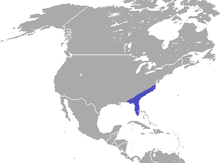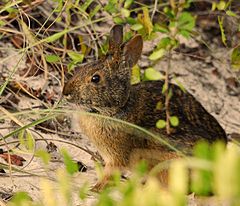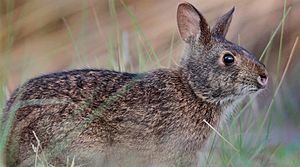
Rabbits, also known as bunnies or bunny rabbits, are small mammals in the family Leporidae of the order Lagomorpha. Oryctolagus cuniculus includes the European rabbit species and its descendants, the world's 305 breeds of domestic rabbit. Sylvilagus includes 13 wild rabbit species, among them the seven types of cottontail. The European rabbit, which has been introduced on every continent except Antarctica, is familiar throughout the world as a wild prey animal and as a domesticated form of livestock and pet. With its widespread effect on ecologies and cultures, the rabbit is, in many areas of the world, a part of daily life—as food, clothing, a companion, and a source of artistic inspiration.

The lagomorphs are the members of the taxonomic order Lagomorpha, of which there are two living families: the Leporidae and the Ochotonidae (pikas). The name of the order is derived from the Ancient Greek lagos + morphē. There are 110 recent species of lagomorph of which 109 are extant, including 34 species of pika, 42 species of rabbit, and 33 species of hare.

Leporidae is the family of rabbits and hares, containing over 70 species of extant mammals in all. The Latin word Leporidae means "those that resemble lepus" (hare). Together with the pikas, the Leporidae constitute the mammalian order Lagomorpha. Leporidae differ from pikas in that they have short, furry tails and elongated ears and hind legs.

The desert cottontail, also known as Audubon's cottontail, is a New World cottontail rabbit, and a member of the family Leporidae. Unlike the European rabbit, they do not form social burrow systems, but compared with some other leporids, they are extremely tolerant of other individuals in their vicinity.

Cottontail rabbits are the leporid species in the genus Sylvilagus, found in the Americas. Most Sylvilagus species have stub tails with white undersides that show when they retreat, giving them their characteristic name. However, this feature is not present in all Sylvilagus nor is it unique to the genus.
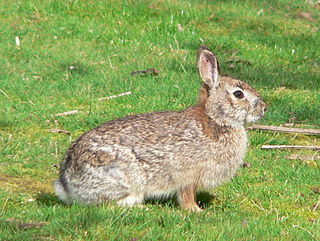
The brush rabbit, or western brush rabbit, or Californian brush rabbit, is a species of cottontail rabbit found in western coastal regions of North America, from the Columbia River in Oregon to the southern tip of the Baja California Peninsula. Its range extends as far east as the eastern sides of the Sierra Nevada and Cascade mountain ranges.

The swamp rabbit, also called the cane-cutter, is a large cottontail rabbit found in the swamps and wetlands of the southern United States. The species has a strong preference for wet areas, and it will take to the water and swim.

The eastern cottontail is a New World cottontail rabbit, a member of the family Leporidae. It is the most common rabbit species in North America.

The commontapeti, also known as the Brazilian cottontail, forest cottontail, or (formerly) simply tapeti is a species of cottontail rabbit. It is small to medium-sized with a small, dark tail, short hind feet, and short ears. As traditionally defined, its range extends from southern Mexico to northern Argentina, but this includes several distinctive population that have since been split into separate species. Under this narrower definition, the true tapeti only occurs in the Atlantic Rainforest of coastal northeastern Brazil and it is classified as "Endangered" by the IUCN. The American Society of Mammalogists concurs, but also tentatively classifies several distinct populations that have not yet received proper species names into S. brasiliensis, and thus considers it to range from Venezuela south to Argentina.

The Omilteme cottontail is a cottontail rabbit found only in the state of Guerrero, Mexico in the mountain range of Sierra Madre del Sur. Belonging to the family Leporidae, it is one of fourteen species in the genus Sylvilagus, a genus restricted to the New World. The Omilteme cottontail is considered one of the most endangered rabbit species in the world and is only known and been described by very few specimens.
East Rockland Key is an island in the lower Florida Keys about 4 miles (6.4 km) east of Key West.

The New England cottontail, also called the gray rabbit, brush rabbit, wood hare, wood rabbit, or cooney, is a species of cottontail rabbit represented by fragmented populations in areas of New England, specifically from southern Maine to southern New York. This species bears a close resemblance to the eastern cottontail, which has been introduced in much of the New England cottontail home range. The eastern cottontail is now more common in it.

The Mexican cottontail is a species of cottontail rabbit in the family Leporidae. It is endemic to Mexico where its natural habitats are temperate forests, subtropical or tropical dry forests and pastureland.

The mountain cottontail or Nuttall's cottontail is a species of mammal in the family Leporidae. It is found in Canada and the United States.

The Appalachian cottontail is a species of cottontail rabbit in the family Leporidae. It is a rare species found in the upland areas of the eastern United States.
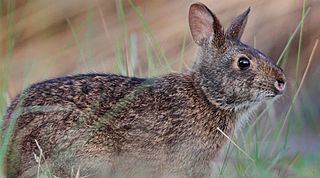
Sylvilagus palustris hefneri, also known commonly as the Lower Keys marsh rabbit, is an endangered subspecies of marsh rabbit in the family Leporidae. The subspecies is named after Playboy founder Hugh Hefner.

The robust cottontail or Holzner's cottontail is a species of cottontail rabbit native to high-altitude regions of the southwestern United States and western Mexico.
Smith Island cottontail, Smith's Island cottontail or Hitchen's cottontail, was a subspecies of the Eastern cottontail rabbit that lived mainly on two islands on the tip of the Delmarva Peninsula in Virginia. It is generally considered to be extinct.
